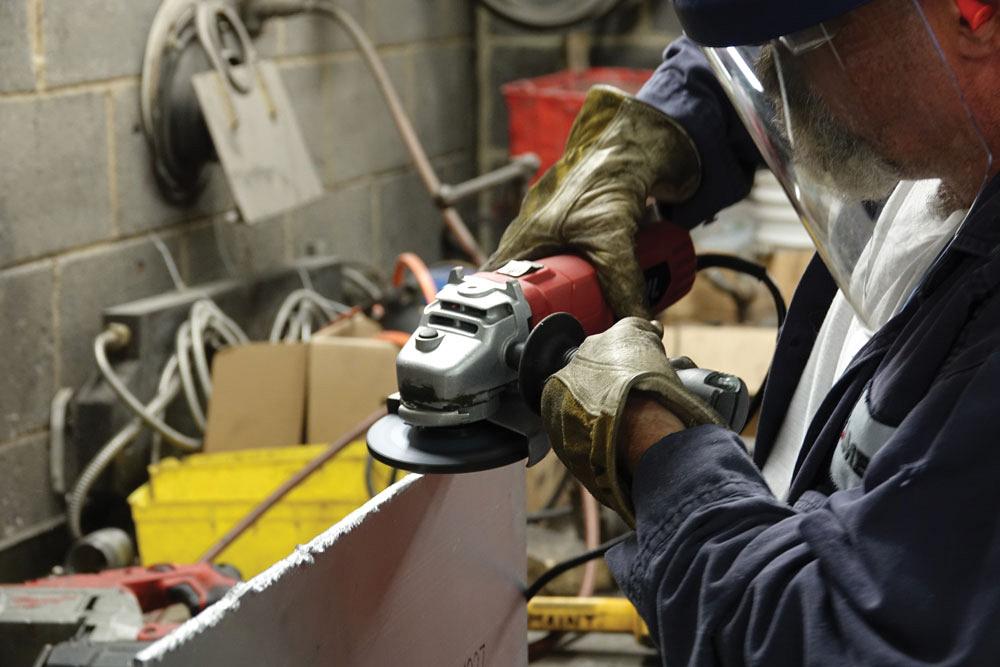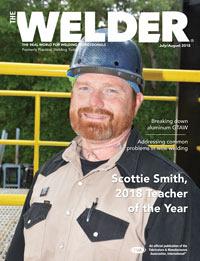Senior District Sales Manager
- FMA
- The Fabricator
- FABTECH
- Canadian Metalworking
Categories
- Additive Manufacturing
- Aluminum Welding
- Arc Welding
- Assembly and Joining
- Automation and Robotics
- Bending and Forming
- Consumables
- Cutting and Weld Prep
- Electric Vehicles
- En Español
- Finishing
- Hydroforming
- Laser Cutting
- Laser Welding
- Machining
- Manufacturing Software
- Materials Handling
- Metals/Materials
- Oxyfuel Cutting
- Plasma Cutting
- Power Tools
- Punching and Other Holemaking
- Roll Forming
- Safety
- Sawing
- Shearing
- Shop Management
- Testing and Measuring
- Tube and Pipe Fabrication
- Tube and Pipe Production
- Waterjet Cutting
Industry Directory
Webcasts
Podcasts
FAB 40
Advertise
Subscribe
Account Login
Search
Cutting, grinding, and finishing
7 tips for success
- By David Jescovitch and Steven Schafer
- July 20, 2018
- Article
- Finishing

When using cutting wheels, hold the tool at a 90-degree angle, perpendicular to the workpiece. This enhances safety and helps improve wheel life and cut rate.
Getting the best results in metal cutting, grinding, and finishing applications is a balance of numerous factors, including choosing the right abrasive product for the job and following best practices for product use and storage. It’s also important to look beyond the specific abrasive application and consider the big picture. What is happening in the entire fabrication or manufacturing process from a cost and productivity perspective?
Before selecting a product, contact your abrasives manufacturer or local distributor to discuss the results you desire. It’s much easier to achieve success when the process and the abrasive product are considered from the beginning. From there, consider these seven common tips to help optimize productivity, performance, and safety in cutting, grinding, and finishing applications.
Tip No. 1: Identify Your Desired End Result
Knowing what you’re trying to accomplish is the first step in choosing the right abrasive product. Completing rough grinding after a deburring operation requires a different process and products than does blending or finishing, for example.
A common pitfall in surface finishing is using the same wheel no matter the job. Always match the abrasive product to the task at hand. Identify your desired results and then plan the process that will produce those results. Choosing the right product for the job requires an understanding of the entire process. Will the part be painted, anodized, or have chemicals applied? All these factors play a role.
vAs a rule, grinding wheels are used for rougher finishes that won’t be painted, while flap discs grind and finish at once and produce relatively fine finishes. Resin-fiber discs can be used for a short lifespan to grind quickly with a relatively fine finish.The desired finish for the material also impacts the needed grain type and grit size of the abrasive product. Generally, 24- through 50-grit discs leave a relatively rough finish and are used to remove a lot of material quickly; 60- to 100-grit discs fall in the middle of the spectrum and are typically used when the surface will be grinded and painted; and grits of 100 or more should be used to achieve fine finishes.
When considering costs, keep in mind the overall process rather than just the cost for each abrasive disc or wheel being used. The required labor and time for any rework can have a big impact on overall costs. For example, a cutting wheel that minimizes surface burn of the material makes part fit-up much easier and faster.
Tip No. 2: Know the Material
The type of material you are grinding or cutting is another key consideration for choosing the right product and getting the best results. Different materials require different conditions and best practices. Stainless steel typically involves more stringent requirements to prevent expensive damage. Products designed specifically for stainless steel help improve material finish and overall work flow by reducing heat buildup and workpiece staining.
When you are working with aluminum, it’s important to reduce the amount of material loading on the wheel or disc face. If your disc is not designed specifically for aluminum, you’ll wind up constantly swapping out a disc or wheel that has been loaded, leading to more downtime and higher overall cost.
Know the material to determine the appropriate bond for grinding or cutting wheels. It’s a good rule to choose a product with a softer bond when conditioning harder materials and choose a product with a harder bond when conditioning softer materials. This helps maximize product life and cutting ability.

A common pitfall in surface finishing is using the same wheel no matter the job. Always match the abrasive product to the task at hand. Different materials require different conditions and best practices.
The bottom line: The more you know about the base material, the better your results.
Tip No. 3: Match the Disc to the Tool
Correctly matching the tool and abrasive can deliver significant cost savings and productivity gains as the efficiency of the abrasive is directly affected by the tool it’s being used on. If the wrong tool is used for the job, problems will arise even with the right accessory. In grinding especially, it’s key to match the appropriate abrasive product to the highest-performing tool (based on amperage or RPM) allowed by the job. For example, using a low-amperage tool with a 14-gauge extension cord can’t turn the grinder fast enough to provide optimal performance.
Tip No. 4: Stay in Motion
With any abrasive product it’s important to keep the wheel or disc in constant, smooth motion and avoid bearing down with heavy pressure or dwelling in one spot. Constant motion reduces the risk of gouging or material damage and helps prevent heat buildup that can cause discoloration.
Pull the initial stroke toward you rather than pushing the tool away from your body. This greatly reduces the risk of gouging, especially when you are using a new wheel.
Tip No. 5: Watch the Angle
Position the tool at a slight angle to the workpiece when grinding. Increasing the angle of the grinding wheel provides more aggressive grinding but reduces wheel life. Reducing the grinding angle lessens the pressure being applied to enhance product life, but it also minimizes cut rate.
Grinding or finishing at an angle that is too steep may cause you to work much harder than necessary since you’re not getting the full benefit the product is designed to provide.
When using cutting wheels, hold the tool at a 90-degree angle, perpendicular to the workpiece. This position enhances safety and helps improve wheel life and cut rate.
It’s critical to use grinding and cutting wheels as designed to enhance safety and get the best performance and efficiency.
Tip No. 6: Store Equipment Properly
Storage recommendations depend on the type of product you use. Resin-bonded abrasives should be stored at ambient temperatures, as exposing them to big temperature swings negatively affects the bonding agent. Compare this to coated abrasives (flap discs), which are less susceptible to changes in temperature.
With any abrasive product, store it in the original packaging when possible. If you remove the disc or wheel from the package and then store it in a toolbox, you may lose track of what type of product it is and what materials it should be used on. Storing the product in the original packaging helps reduce the risk of cross contamination, which is a critical issue in some applications. Any product used on carbon steel, for instance, should not be used on stainless steel or aluminum.
The risk for contamination is high when a wheel is left on a grinder. When the grinder is taken back to the toolroom, it becomes difficult to remember which material the product was used on previously.
In addition to proper storage, always inspect the abrasive product and the tool for any cracks or damage before using it.
Tip No. 7: Always Be Safe
Beyond choosing the right product, following proper safety procedures is also critical to success. The most important safety practice is to always use the tool guard.
Safe operation also involves watching the speed. The RPM rating of the accessory should meet or exceed the RPM rating of the tool. For example, a 7-in. grinding wheel that is worn down to a smaller size should not be used on a 5-in. grinder, because the wheel was not designed to be used at the much higher speed of the smaller tool. Also, if you can’t read the RPM rating on either the tool or the abrasive product, don’t use them.
It’s also unsafe to use an abrasive product on a task for which it wasn’t designed, such as using the sides of a cutoff wheel to perform grinding or deburring. Grinding with the side of a cutoff wheel—even for a few seconds—can damage the wheel and reduce the fiberglass reinforcement, causing the wheel to break apart.
Any product modifications can compromise safety and efficiency. Be sure you’re following the recommendations for proper use. You can also try using a different wheel or disc to improve performance for the application.
David Jescovitch is abrasive specialist manager and Stephen Schafer is territory manager at Weiler Abrasives Group, 1 Weiler Drive, Cresco, PA 18326, 800-835-9999, www.weilerabrasives.com.
About the Authors
David Jescovitch
1 Weiler Drive
Cresco, PA 18326
570-595-7495
Steven Schafer
Territory Manager
1 Weiler Drive
Cresco, PA 18326
(800)-835-9999
About the Publication
subscribe now

The Welder, formerly known as Practical Welding Today, is a showcase of the real people who make the products we use and work with every day. This magazine has served the welding community in North America well for more than 20 years.
start your free subscription- Stay connected from anywhere

Easily access valuable industry resources now with full access to the digital edition of The Fabricator.

Easily access valuable industry resources now with full access to the digital edition of The Welder.

Easily access valuable industry resources now with full access to the digital edition of The Tube and Pipe Journal.
- Podcasting
- Podcast:
- The Fabricator Podcast
- Published:
- 04/16/2024
- Running Time:
- 63:29
In this episode of The Fabricator Podcast, Caleb Chamberlain, co-founder and CEO of OSH Cut, discusses his company’s...
- Trending Articles
Sheffield Forgemasters makes global leap in welding technology

Welding student from Utah to represent the U.S. at WorldSkills 2024

Lincoln Electric announces executive appointments

Engine-driven welding machines include integrated air compressors

ESAB unveils Texas facility renovation

- Industry Events
16th Annual Safety Conference
- April 30 - May 1, 2024
- Elgin,
Pipe and Tube Conference
- May 21 - 22, 2024
- Omaha, NE
World-Class Roll Forming Workshop
- June 5 - 6, 2024
- Louisville, KY
Advanced Laser Application Workshop
- June 25 - 27, 2024
- Novi, MI


























